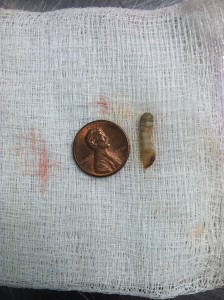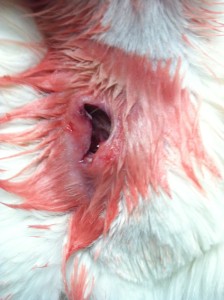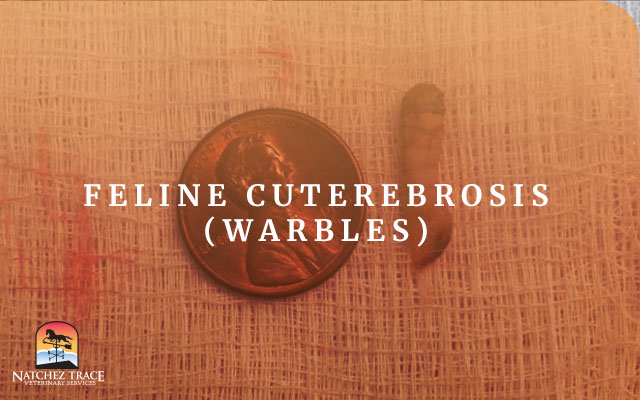Recently, a cat was brought into our clinic with a cyst-like protrusion on its chest. Examination revealed it to be Feline Cuterebrosis, also called “Warbles”, a condition in which fly larvae live in the flesh of cats.
What Is Feline Cuterebrosis?
Feline Cuterebrosis is a condition occurring when a cat has become the host of the larval stage of the Cuterebra Fly, commonly known as the Botfly.
There are twenty-six known species of the Botfly (Cuterebra) in the United States and Canada.
This condition is often called “Warbles” because the larvae create a burrow with a breathing hole just under the skin causing a lump on the surface of the skin. These lumps are called “warbles”, hence the name.

Warbles are usually found under the skin in areas around the legs and neck. Cuterebrosis is most commonly found in rodents and rabbits, but have also been reported on cats, dogs, hogs, mink, foxes, deer, cattle, and humans.
What Causes Feline Cuterebrosis?
Cuterebrosis is a condition most commonly found in wild rodents and rabbits. This condition is caused by the larvae of the Cuterebra fly, which also known as the botfly.

The female botfly, genus Cuterebura, lays eggs along the runways and burrow entrances of rabbits and small rodents. The eggs hatch and turn into larvae which enter the unsuspecting host through a natural body opening (usually the nose or mouth) or a small abrasion on the skin.
The larvae will often remain in an animal’s the nose or mouth for several days before burrowing under the skin where they develop into “warbles”. (“Warbles” is the name given to the small lumps produced by growing larvae.) The larvae live and grow just under the skin inside the “warbles”, where they breathe and excrete.
Cats most likely contract Cuterebrosis by coming in contact with the newly hatched and unsettled larvae from rodents caught hunting, or from activity around rodent burrows and runways.
Most cats are asymptomatic in the early stages of Feline Cuterebrosis, but sometimes migrating larva can sometimes cause eye problems, nervous system symptoms, and respiratory issues as they move through these systems.

How is Feline Cuterebrosis (Warbles) Treated?
Feline Cuterebrosis is treated by carefully removing the larvae and thorough cleaning of the area involved.
Often the cat will be given antibiotics or an antibiotic injection to treat any possible or already occurring secondary infection.
This particular procedure was done under anesthesia and the cat was given an antibiotic injection to treat and prevent secondary infection.
Sources:
- Cat Health
- Department of Natural Resources
- Vet Next







